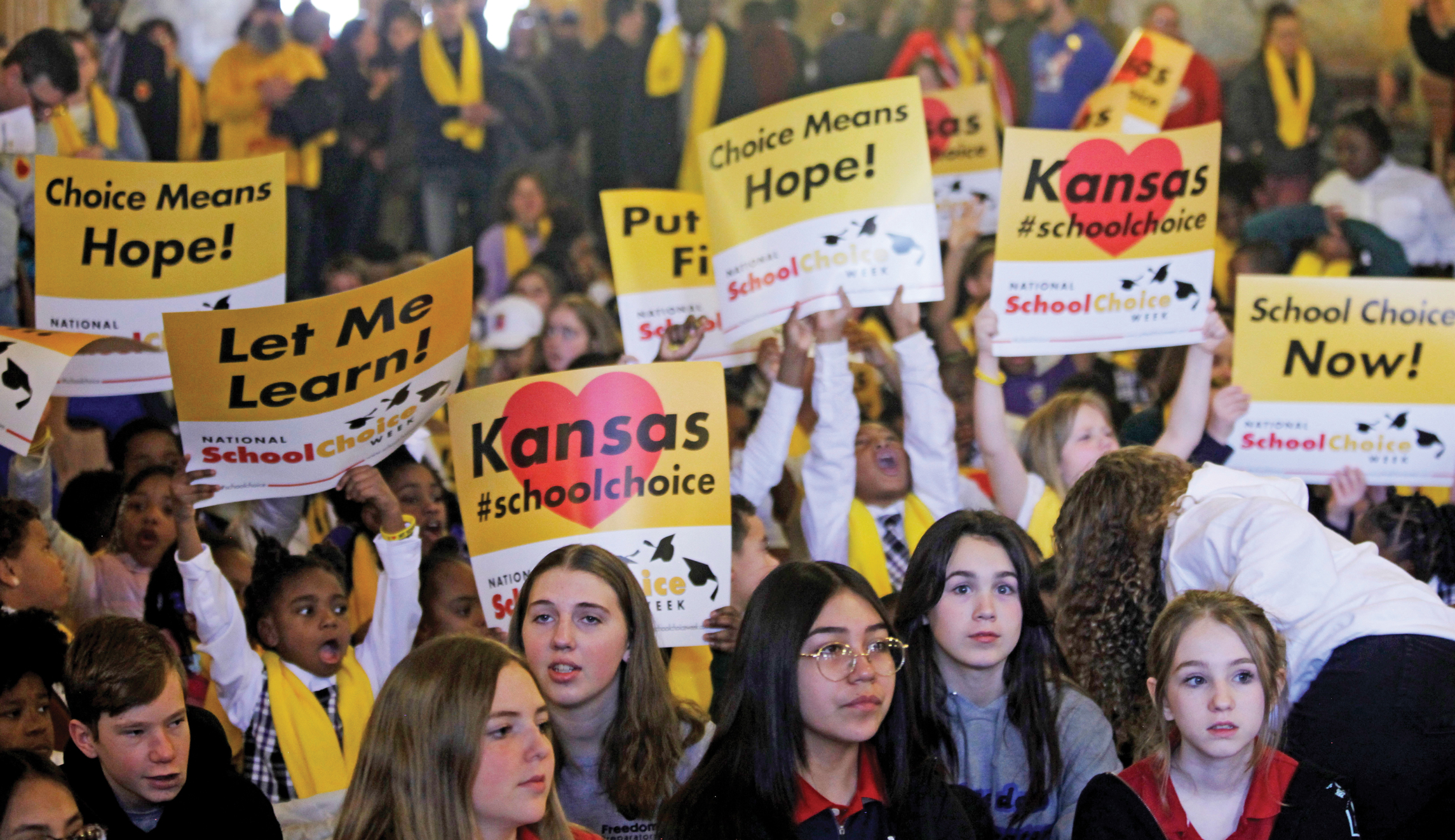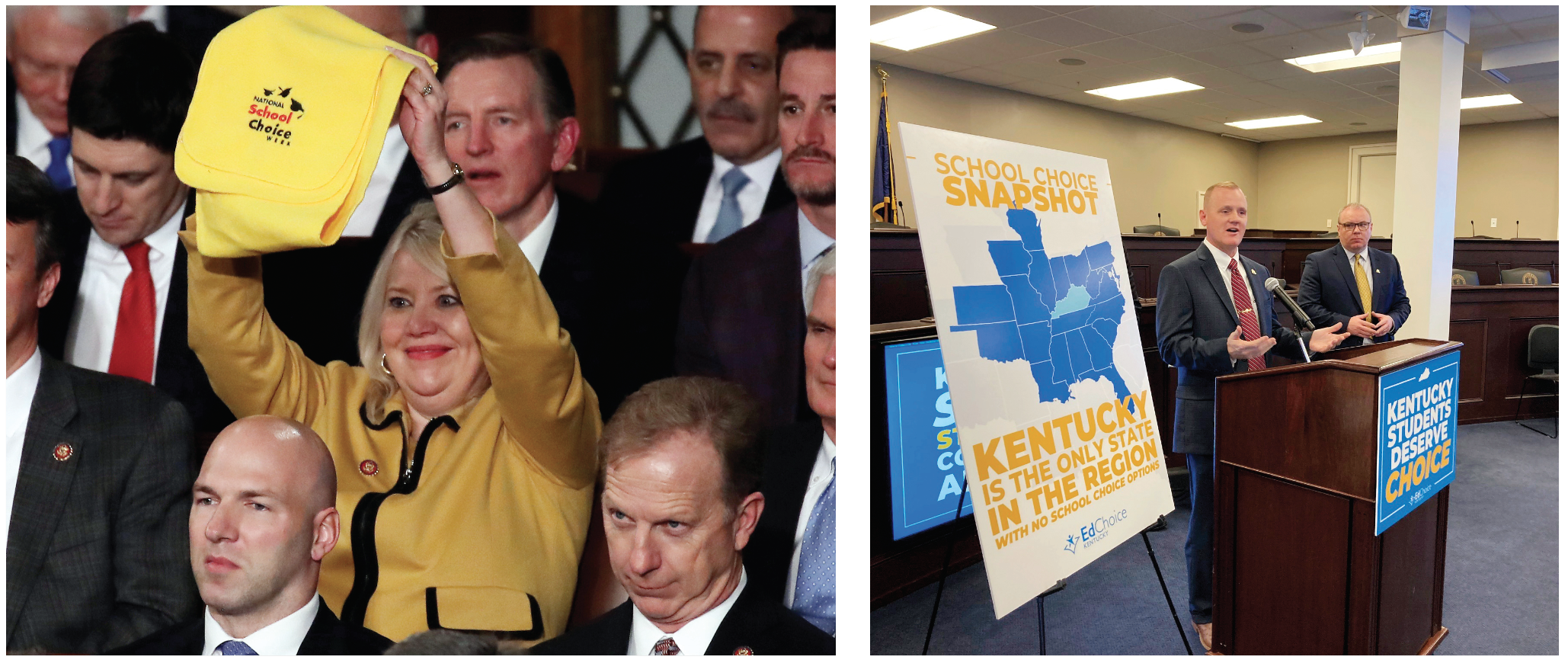
The school choice revolution is here, and it isn’t going away. The past two legislative cycles brought the most significant advancements for school choice in United States history, and already in 2023, states are racing to make this cycle even bigger.
The progress of school choice in the last 30 years resembles an exponential function. Throughout the history of school choice, expansions have come through slow, incremental policy changes that garnered little national attention and expanded education options to small groups of students. Further, they have been predominantly accessible to lower-income families and students with special learning needs.
Everything changed in the last few years. Prompted by COVID-19-induced parent outrage,
24
states mobilized to create, expand, or improve school choice programs. Finally, in 2022,
Arizona
and
West Virginia
established the first universal school choice programs in the U.S. Every Arizona and West Virginia student is now eligible for an education that meets his or her individual needs.
DESANTIS CALLS THE BUREAUCRATS’ BLUFF
Those victories might as well have been the starting gun for the school choice race. Since the program’s passage, Republican lawmakers and others around the country have mobilized to pass their own universal bills. Already this year,
Iowa and Utah
passed laws granting education savings accounts to every student in their respective states. These advancements represent the fundamental belief that all students, regardless of ZIP code or family income, should be able to choose the education that best meets their individual needs. For the first time, that principle is becoming a reality.
The question remains: Why now? Why is the school choice movement experiencing such vibrant popularity? The ideals of education freedom are not new. The first school choice program was
created
in the early 1990s. Further,
majorities
of the public have supported school choice for years now. It’s not controversial to argue that your ZIP code shouldn’t determine your destiny.

Undeniably, COVID-19 played a
major
role. The pandemic exposed the flaws in our education system to parents and lawmakers, and the resulting school shutdowns mobilized parents to exercise their political voice. Yet the pandemic is not the reason for such continued success.
Shutdowns might have lit the fire, but there are two fundamental reasons why school choice is here to stay: First, lawmakers want to be known as school choice champions and are willing to compete with each other, and second, they have finally realized that school choice is a major electoral winner.
First, let’s consider the growth of interstate rivalries. From college football to the best place to snag a slice of pizza, competitions between states are a pertinacious piece of American social consciousness. Lawmakers want their state to be a place where people want to live. They also want to beat their contemporaries in neighboring states. Thankfully, for the benefit of K-12 schoolchildren across the country, friendly competitions over education are resulting in a sustained push for bigger and better school choice laws.
Governors aren’t hiding their desire to be the best. Iowa set the standard in late July when Gov. Kim Reynolds (R-IA) signed the
Students First Act
, which will give all students access to ESAs within three years. One week later, during a committee hearing on a school choice bill, Gov. Jim Pillen (R-NE)
remarked
, “We all agree we don’t want Iowa to beat us.”
Last week, Gov. Kevin Stitt (R-OK) used his State of the State
address
to say, “Other states like Iowa and Virginia and Florida and New Hampshire have already figured it out. Providing more options for students leads to better outcomes. Oklahoma cannot afford to be left behind.”
In August, after Arizona’s landmark school choice expansion, I authored a piece
titled
, “Florida just lost its school choice crown, can we get it back?” It didn’t take long for Florida lawmakers to start attempting just that, with House Speaker Paul Renner and state Rep. Kaylee Tuck recently
proposing
universal legislation that will help Florida retake the school choice top spot.
Lawmakers want their states to be places where families want to live. Education options are a significant piece of that picture. A robust education system is a draw for families and has the long-term effect of boosting outcomes. An
analysis
of Florida’s tax credit scholarship program showed that students using the program for more than four years were 99% more likely to attend college. Expanding choice is a quick way to make your state more competitive.

Legislators realize that school choice laws provide a much-needed shot in the arm to America’s education system. Competition between schools will improve the quality of education, and the ability of families to choose a school that meets their individual needs will lead to greater educational outcomes for all students. Competition between lawmakers in passing school choice is leading to competition between education providers. Students and families remain the prime beneficiaries.
Nowhere is this dynamic more obvious than in Nebraska. The Cornhusker State is one of only two without a school choice program. Pillen’s
statement of support
of school choice noted, “Currently, Nebraska remains one of only two states that does not support school choice. This leaves us uncompetitive with neighboring states.” A landmark school choice bill is now making its way through the Nebraska legislature, and leaders would be wise to take action to increase competitiveness.
The second and related reason for the growth of school choice proposals is that school choice has become politically profitable. All politics is local, and nothing is more central to parents than their children’s education. The will of the voters truly manifests during elections, and the desires of parents are becoming apparent at the ballot box.
In 2018,
school choice mothers
crossed party lines to give Gov. Ron DeSantis (R-FL) the victory in the Sunshine State. In Virginia’s
gubernatorial race
, outraged parents helped Gov. Glenn Youngkin (R-VA) soundly defeat former Gov. Terry McAuliffe (D-VA), a teachers union supporter who actually asserted, “I don’t think parents should be telling schools what they should teach.” Unsurprisingly, parents weren’t too happy about that, and they made McAuliffe pay at the ballot box.
This cycle, Reynolds, Stitt, Gov. Greg Abbott (R-TX), and Gov. Sarah Huckabee Sanders (R-AR) all rode to victory in their respective states by making school choice a major part of their campaign — and are now working hard to deliver on their promises.
Iowa provides a good example of how this is working. It is impossible to separate Iowa’s school choice victory from Reynolds’s willingness to challenge members of her own party who opposed school choice. Last spring, Reynolds
stood against
Republican incumbents who failed to support school choice in the previous legislative session and successfully removed several from office. The victorious members were instrumental in passing Iowa’s school choice bill this year and provide the clearest example of why the school choice revolution is happening.
School choice played a major role in other state legislative races as well, especially as school choice has become a major
litmus test
for Republicans. Across 17 states, 75% of the state legislative candidates supported by my organization, the American Federation for Children, won their races in 2022.
As a columnist at New Yorker magazine
lamented
, “education freedom” candidates “fared depressingly well” in the midterm elections. While that might not be good news for some commentators, it’s great news for families desiring education options.
Democrats aren’t blind to the importance of school choice either. In an admittedly more limited fashion,
several
high-profile Democratic candidates came out in support of education freedom during last year’s gubernatorial elections. Most notably, Gov. Josh Shapiro (D-PA)
voiced support
for increased education options and for “Lifeline Scholarships,” the name of Pennsylvania’s ESA proposal. Recently, Gov. Kathy Hochul (D-NY) also
publicly signaled
her desire to remove the longtime cap on charter schools in New York City. Hopefully, more Democrats will read the tea leaves and conclude that school choice is important to voters.
The way that school choice is cementing itself in electoral politics is critical for the long-term success of the movement. Lawmakers need to reflect the voices of their constituents in creating and protecting school choice programs, and those who do not should be voted out.
According to recent
polling
from RealClear Opinion Research, 72% of registered voters support the concept of school choice and 75% believe that parents should oversee decisions regarding their child’s education. The numbers are even higher among Republicans. A one-size-fits-all, monopolistic education system is not what’s best for students or what people want. When campaign season returns, Republicans and Democrats alike should consider their voting records on school choice legislation and whether it’s wise to accept teachers union campaign donations.
Corey DeAngelis, a senior fellow at the American Federation for Children, said it best: “A universal school choice revolution has ignited, and there’s no stopping it. The government school monopoly dominoes are falling, and there’s nothing the teachers unions can do about it.”
FOR MORE FROM THE WASHINGTON EXAMINER MAGAZINE
And the year of the school choice revolution is far from over. Wyoming’s Senate recently passed a universal school choice bill, and South Carolina’s Senate passed one limited to students within certain income thresholds. Other states with active legislation include Arkansas, Florida, Idaho, Indiana, Nebraska, Ohio, Oklahoma, and Texas. Each is racing to be the state that strikes next.
With each victory, lawmakers are incentivized to extend opportunities to the children in their state. Despite the progress made over the last two years, millions of families still lack education choice. Lawmakers should learn from what’s happening and pursue freedom for students in their own states with similar boldness.
Nathan Cunneen is a communications strategist at the American Federation for Children and a former beneficiary of school choice programs.







